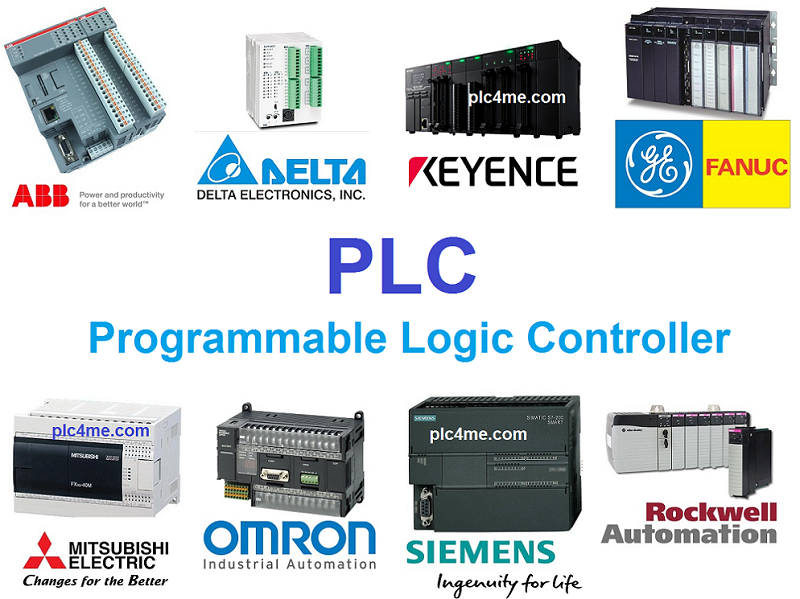PLC stands for Programmable Logic Controller ( can be understood simply: the control device allows the user to program )
In the past, controllers were only made to serve a control purpose and cannot be changed ( called the hard connection controller ), this has created huge limitations and disadvantages in programming control so PLC was born. Through the PLC controller, users can completely change the control algorithm through PLC programming ( written in programming languages ).
Some famous PLC manufacturers in the world : Siemens (Germany), ABB (Switzerland), RockWell (U.S), GE-Fanuc (U.S), Omron (Japan), Keyence (Japan), Mitsubishi (Japan), Delta (Taiwan)…

- Advantages of PLC over hard-connected control systems
# Features of the hard connection control system (using relay, timer, counter, contactor …) :
+ Lots of wires.
+ Replacement is very complicated.
+ Need skilled repair workers.
+ It is difficult to update the diagram, making it difficult for maintenance and replacement.
+ There is no high aesthetic
+ Takes the area of the control cabinet, large power consumption.
+ Time to repair or change operating procedures takes a lot of time.
# Characteristics of PLC control system :
+ Reduce 80% number of extension cord.
+ PLC power consumption is very low.
+ Has a self-diagnosis function so that the repair work is quick and easy.
+ Control functions can be easily changed by programming devices (software, programming device) without hardware changes if there is no requirement to add or remove devices.
+ Communicate with other smart devices such as computers, networking, expansion modules.
+ Large memory capacity to accommodate complex programs.
+ The number of relays and timers is much less than the classical control system.
+ The number of contacts in the program used is not limited.
+ The time to complete a control cycle is very fast (several ms).
+ Easy to learn programming languages> easy programming and changing programs.
+ Compact > easy to maintenance, repair.
+ High reliability, small size, completely reliable in industrial environments.
+ Adaptation in harsh environments: Temperature, humidity, voltage fluctuations …
- Structure of PLC
Image of PLC structure

# Central Processing Unit (CPU) : It is a microprocessor that controls all PLC activities such as program execution, Input/Output processing and communication with external devices.
# Memory (RAM / ROM) : Used to store programs and data. Most PLCs have to use batteries to feed memory, but newer PLCs do not need batteries to store programs and data.
# Input Signal : The intelligence of a control system depends mainly on the ability of the PLC to read different data from the sensors as well as by manual input devices
+ Manual input devices : Push buttons, keypads and switches, …
+ Sensor : Cruise switch, photoelectric sensor, fiber optic sensor, magnetic sensor, pressure sensor, …
The input signal to the PLC can be a digital or analog signal, these signals are communicated with the PLC through different input modules DI (Digital Input) or AI (Analog Input), …
# Output Signal : A control system will have no practical meaning if it is not possible to communicate with external equipment, common external devices such as motors, valves, relays, indicator lights, electric bells, etc. just like the equipment. In, external devices are connected to the output ports of the output module.
These output modules can be DO(Digital Output) or AO(analog output) , Relay output or Transistor / Triac output .
# Other Modules : There are many modules with special functions that help the PLC to communicate with peripheral devices
Enthernet Module, CC-Link Module, RS232/485 Module, Position Module, Modbus Module , EtherCAT Module, …
- Working principle of PLC

+ The signals from external devices (sensors, contacts, etc.) are first fed to the CPU via the input module. After receiving the input signal, the CPU will process and send the control signals through the output module to external controlled devices according to a preprogrammed program.

+ A cycle consists of reading input signals, executing programs, internal communication, checking errors, sending updates to the output signal called a scan cycle or a scan cycle (Scan Cycle).
Usually, a scan takes a very short time (from 1ms to 100ms). The time taken for this scan depends on the speed of the PLC’s command processing, the short length of the program, the communication speed between the PLC and peripheral devices.
>>> The first PLC was created in 1968 by General Motors, so far PLC has become an integral part of industrial automation. Currently with the Industrial Revolution 4.0, the PLC has more modern features (IoT, SCADA) and is becoming cheaper, so the PLC will become increasingly popular in the future.







Hey man, do you have Rockwell software?
i have but can’t share
ok
ok sir